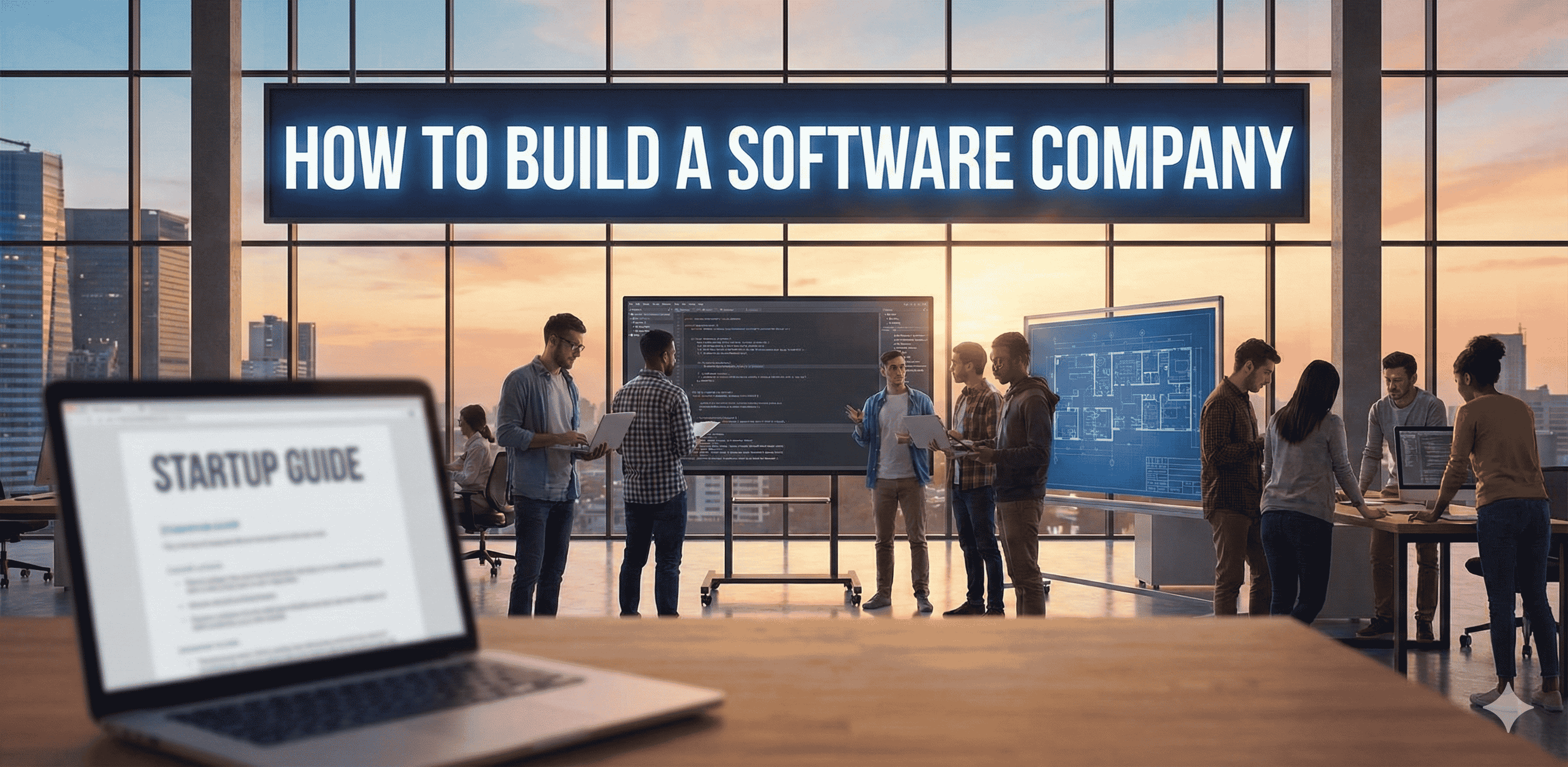TL;DR
-
There are three very different kinds of software companies:
- Product-led, lower-ticket SaaS, Notion
- Sales-led, high-ticket SaaS, GPTZero
- Custom software development agencies Manaknight Digital
-
They are built and run in different ways: product-led optimizes for volume and self-serve, sales-led optimizes for fewer but bigger accounts and hands-on onboarding, agencies build software for clients and hand it over.
-
No matter the type, the build process is a sequence:
→ detailed requirements
→ wireframes & BRDs
→ UX design
→ architecture
→ time-boxed development
→ QA
-
After launch, the focus shifts to marketing, sales, and continuous improvement, with a small team of devs and QA keeping the product alive and stable.
Many people have asked me this question: How does one actually build a software company?
Not just "how do you code an app," but how you go from an idea in your head to a real organization that ships software, gets customers, and survives long enough to see version 10.0.
When I zoom out and look at my own experience and the companies around me, I keep coming back to the idea that there isn’t just one type of software company. There are really three:
The three types of software companies I keep seeing
1. Product led, lower ticket SaaS
This is the classic "sign up with your credit card and start clicking around" kind of product.
- The software is self-serve by design.
- The dream is that a customer can land on the site, understand the value, sign up, and start using it without talking to a human.
- Onboarding happens through tooltips, checklists, and good UX, not Zoom calls.
- The business model is built around volume of subscriptions at a lower price point.
In this world, every friction point is expensive. If you need to hand hold every new user, the math breaks.
2. Sales led, high ticket SaaS
Then there is the opposite: systems built for complicated, high stakes workflows risk, finance, insurance, operations, that kind of thing.
- The software is there to handle complex tasks, usually with many edge cases.
- The company is effectively selling software + consulting.
- You expect a sales call, a demo, maybe a proof of concept, and several onboarding sessions.
- Prices are higher, deals are fewer, and each customer relationship is deeper.
Here, the sales team becomes the front line. The product doesn’t have to be as "dummy proof" in the same way, because your sales and onboarding people walk customers through it. The UI still matters, but it doesn’t have to carry the full load of onboarding by itself.
3. Custom software development agency
Finally, there’s the custom software development agency.
This is a company that builds software for other people, not for itself. Clients come with problems; the agency designs and builds tailored web apps, mobile apps, AI tools, or automation systems. Manaknight Digital is a good example: a Canadian agency that specializes in custom web, mobile, and AI software for startups and SMBs, with a process that covers estimation, wireframing, development, QA and ongoing support.
Key traits of this model:
- You don’t own the product; the client does.
- Revenue comes from projects, retainers, and hours, not subscriptions to your own SaaS.
- Once the system is delivered and accepted, the client is responsible for running the rest of the business around it.
Same bricks, different houses
What surprised me over time is that all three company types use the same basic build steps.
The difference is what happens after the software is working.
But let me walk through the steps first, because this is the part most people underestimate.
Step 1: Write the requirements in painful detail
Every time I skip this, I pay for it later.
The first real step is to write down the requirements of the software you want to build, in as much detail as your brain can squeeze out:
- What problems does it solve?
- Who is using it, and what do they do screen by screen?
- What data needs to be stored?
- What happens in the weird edge cases?
This is not about wordsmithing. It’s about thinking clearly. You’re essentially writing a story about how the system behaves.
Step 2: Wireframes and business requirement documents
Once the initial requirements exist in words, I shift into visual mode.
- I create wireframes so everyone can see the product in sketch form.
- These are not polished designs. They’re rough boxes and labels: what goes where, which button leads to which page.
- Alongside that, I create any Business Requirement Documents (BRDs) or supporting specs needed to keep everyone aligned flows, roles, permissions, success criteria.
Wireframes are powerful because they catch misunderstandings early. It’s a lot cheaper to erase a box than to rebuild a feature.
Step 3: UX design and the final look
Now a proper UX designer comes in.
Their job isn’t just to make things pretty. It’s to:
- Turn wireframes into the final visual design.
- Clarify user interactions: what happens on hover, what error states look like, what the empty states say.
- Make sure the product feels coherent and not like ten separate tools taped together.
At this stage, for a product led company, the UX work is absolutely core. The product itself has to explain itself, because you’re not planning to jump on onboarding calls with every new user.
Step 4: Architecture and tech stack
Next, a software architect or senior developer plans how the thing will actually work under the hood:
- Which technology stack to use (frontend, backend, database, hosting).
- How to structure the architecture (services, APIs, modules).
- How to handle security, scaling, logging, monitoring.
This is where good decisions save you from future pain. A rushed stack choice can lock you into months of rework later.
Step 5: Build in time boxed releases
Then comes the part everyone recognizes: development.
The key for me is to avoid "we’ll ship when it’s done" thinking. Instead:
- Work in time bounded releases (sprints, phases, milestones).
- Each release delivers something real: a working module, a functional MVP, a new feature set.
- You keep feedback loops short and expectations concrete.
Whether you’re a product led SaaS, a sales led system, or an agency, this rhythm helps everyone stay sane.
Step 6: Quality assurance until the bugs are acceptable
Once the product feels "done," it moves into Quality Assurance (QA).
- QA engineers test flows, edge cases, integrations, and performance.
- The goal isn’t to find every tiny defect; it’s to reach a point where no major bugs remain and the risk of serious issues in production is low.
One lesson I’ve learned repeatedly: The person who builds the feature should not be the one who certifies it.
Developers are biased toward their own work. A dedicated QA role catches what the builder overlooks.
Fork in the road: what happens after launch?
After QA, the path divides based on the type of company.
For a custom software development agency
If you’re a custom development shop, your main job often ends here:
- You’ve delivered the software that the client requested.
- The client is responsible for running the business, handling support, marketing, and sales.
- You may stay on as a maintenance or feature build partner, but the ongoing commercial risk shifts to them.
This is why agencies tend to obsess over scope, timelines, and acceptance criteria. That’s the core of the business.
For a product led SaaS company
If you’re product led, launch is only the beginning.
Once the software works:
- You bring in marketing and product design specialists to make sure the product is as dummy proof as possible.
- Every screen needs to guide a new user without explanations.
- Documentation, empty states, onboarding flows, and prompts become part of the "sales team."
Product led companies deliberately avoid custom onboarding, because:
- The economics depend on volume.
- The more manual hand holding you do, the more your cost to serve creeps up and kills margin.
- Self serve is not just a design choice; it’s a business requirement.
For a sales led SaaS company
If you’re sales led, the center of gravity is different.
Once the software is working:
- You focus heavily on selling the product: demos, pitches, pilots, procurement cycles.
- Your sales team and account managers handle onboarding and training.
- The user experience still matters, but you accept that your team will walk clients through it. The interface doesn’t need to do all the teaching on its own.
Because deals are high ticket, you don’t need thousands of customers. You need the right few, and you invest deeply in each.
After launch: marketing, selling, and staying alive
In all three models, once the core product is working, the company’s attention shifts to getting and keeping customers.
Common ways I see people market and sell:
- Cold calling potential customers.
- Cold emailing with tailored messaging.
- Using LinkedIn for outbound, content, and networking.
- Attending events and meetups.
- Setting up partnerships where another company brings you leads.
The specifics vary by niche, but the principle is the same: The product doesn’t sell itself. Someone has to go out and talk to humans.
Keeping the lights on: maintenance and new features
Over time, reality kicks in:
- Customers request new features.
- Edge cases show up in production.
- Integrations change, APIs break, browsers update.
So your development team shifts into a rhythm of maintaining and scaling the software:
- Fixing bugs.
- Refactoring rough parts.
- Building new modules.
- Keeping performance acceptable as usage grows.
The typical team here looks like:
- A Team lead who supervises developers, manages priorities, and connects with stakeholders.
- Frontend developers who focus on the UI and everything the user sees and interacts with.
- Backend developers who handle server logic, data processing, integrations, and infrastructure.
- Quality Assurance engineers who keep testing every change, because the person writing the code shouldn’t be the one stamping it as ready.
This cycle never really ends. A living product is always slightly unfinished.
The quiet truth
When I strip away the noise, building a software company feels less like a lightning strike idea and more like a steady sequence:
- Think clearly and write everything down.
- Draw it.
- Design it.
- Architect it.
- Build it in chunks.
- Test it until it behaves.
- Then, depending on your model, either hand it off (agency), scale it quietly through self serve (product led), or send in the sales team (sales led).
- And finally, keep showing up: market it, sell it, maintain it, and improve it.
That’s the part that doesn’t fit into a one line quote, but it’s the part that actually builds the company.




